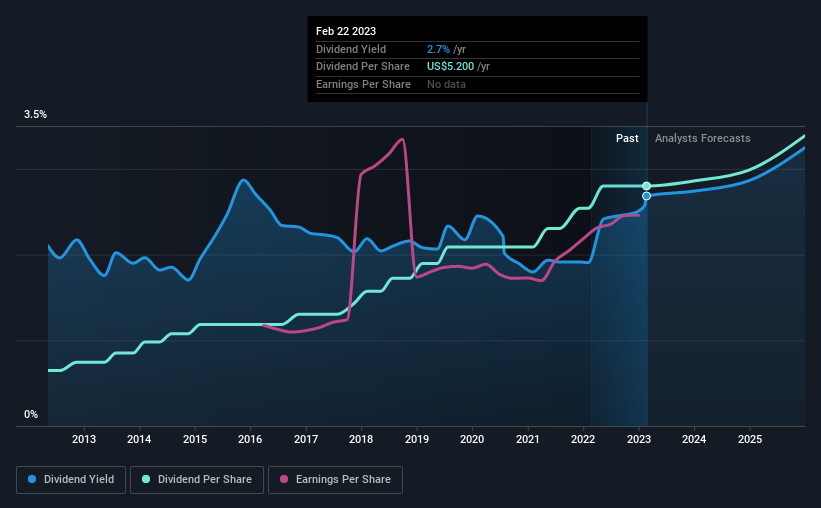Interested In Union Pacific's (NYSE:UNP) Upcoming US$1.30 Dividend? You Have Four Days Left
It looks like Union Pacific Corporation (NYSE:UNP) is about to go ex-dividend in the next four days. Typically, the ex-dividend date is one business day before the record date which is the date on which a company determines the shareholders eligible to receive a dividend. The ex-dividend date is of consequence because whenever a stock is bought or sold, the trade takes at least two business day to settle. This means that investors who purchase Union Pacific's shares on or after the 27th of February will not receive the dividend, which will be paid on the 31st of March.
The company's next dividend payment will be US$1.30 per share, and in the last 12 months, the company paid a total of US$5.20 per share. Based on the last year's worth of payments, Union Pacific has a trailing yield of 2.7% on the current stock price of $193.75. If you buy this business for its dividend, you should have an idea of whether Union Pacific's dividend is reliable and sustainable. So we need to check whether the dividend payments are covered, and if earnings are growing.
See our latest analysis for Union Pacific
If a company pays out more in dividends than it earned, then the dividend might become unsustainable - hardly an ideal situation. That's why it's good to see Union Pacific paying out a modest 45% of its earnings. That said, even highly profitable companies sometimes might not generate enough cash to pay the dividend, which is why we should always check if the dividend is covered by cash flow. It paid out more than half (55%) of its free cash flow in the past year, which is within an average range for most companies.
It's positive to see that Union Pacific's dividend is covered by both profits and cash flow, since this is generally a sign that the dividend is sustainable, and a lower payout ratio usually suggests a greater margin of safety before the dividend gets cut.
Click here to see the company's payout ratio, plus analyst estimates of its future dividends.
Have Earnings And Dividends Been Growing?
Businesses with shrinking earnings are tricky from a dividend perspective. Investors love dividends, so if earnings fall and the dividend is reduced, expect a stock to be sold off heavily at the same time. That's why it's not ideal to see Union Pacific's earnings per share have been shrinking at 3.1% a year over the previous five years.
Another key way to measure a company's dividend prospects is by measuring its historical rate of dividend growth. Union Pacific has delivered an average of 16% per year annual increase in its dividend, based on the past 10 years of dividend payments.
The Bottom Line
From a dividend perspective, should investors buy or avoid Union Pacific? Its earnings per share have been declining meaningfully, although it is paying out less than half its income and more than half its cash flow as dividends. Neither payout ratio appears an immediate concern, but we're concerned about the earnings. Overall we're not hugely bearish on the stock, but there are likely better dividend investments out there.
With that being said, if dividends aren't your biggest concern with Union Pacific, you should know about the other risks facing this business. Case in point: We've spotted 1 warning sign for Union Pacific you should be aware of.
If you're in the market for strong dividend payers, we recommend checking our selection of top dividend stocks.
Have feedback on this article? Concerned about the content? Get in touch with us directly. Alternatively, email editorial-team (at) simplywallst.com.
This article by Simply Wall St is general in nature. We provide commentary based on historical data and analyst forecasts only using an unbiased methodology and our articles are not intended to be financial advice. It does not constitute a recommendation to buy or sell any stock, and does not take account of your objectives, or your financial situation. We aim to bring you long-term focused analysis driven by fundamental data. Note that our analysis may not factor in the latest price-sensitive company announcements or qualitative material. Simply Wall St has no position in any stocks mentioned.
Join A Paid User Research Session
You’ll receive a US$30 Amazon Gift card for 1 hour of your time while helping us build better investing tools for the individual investors like yourself. Sign up here



